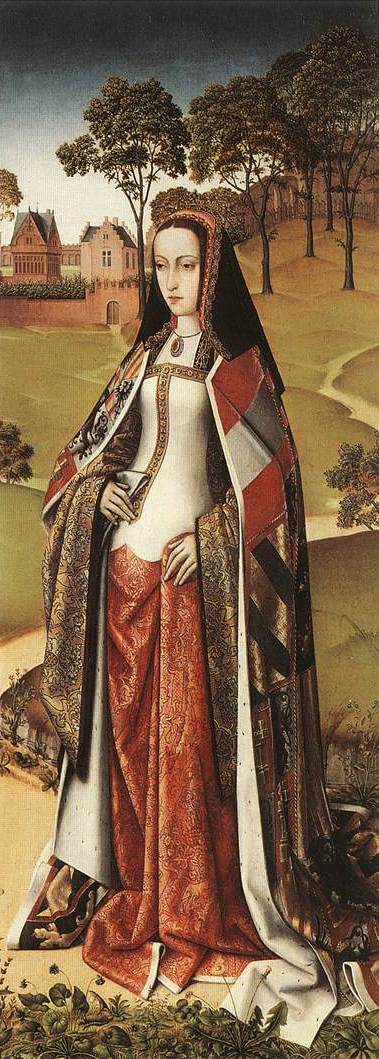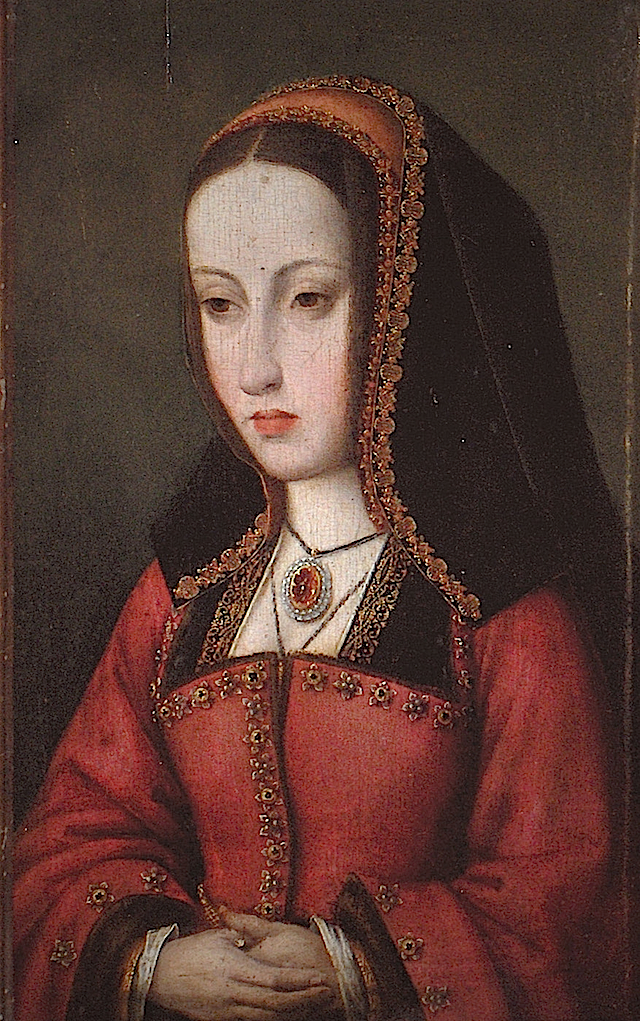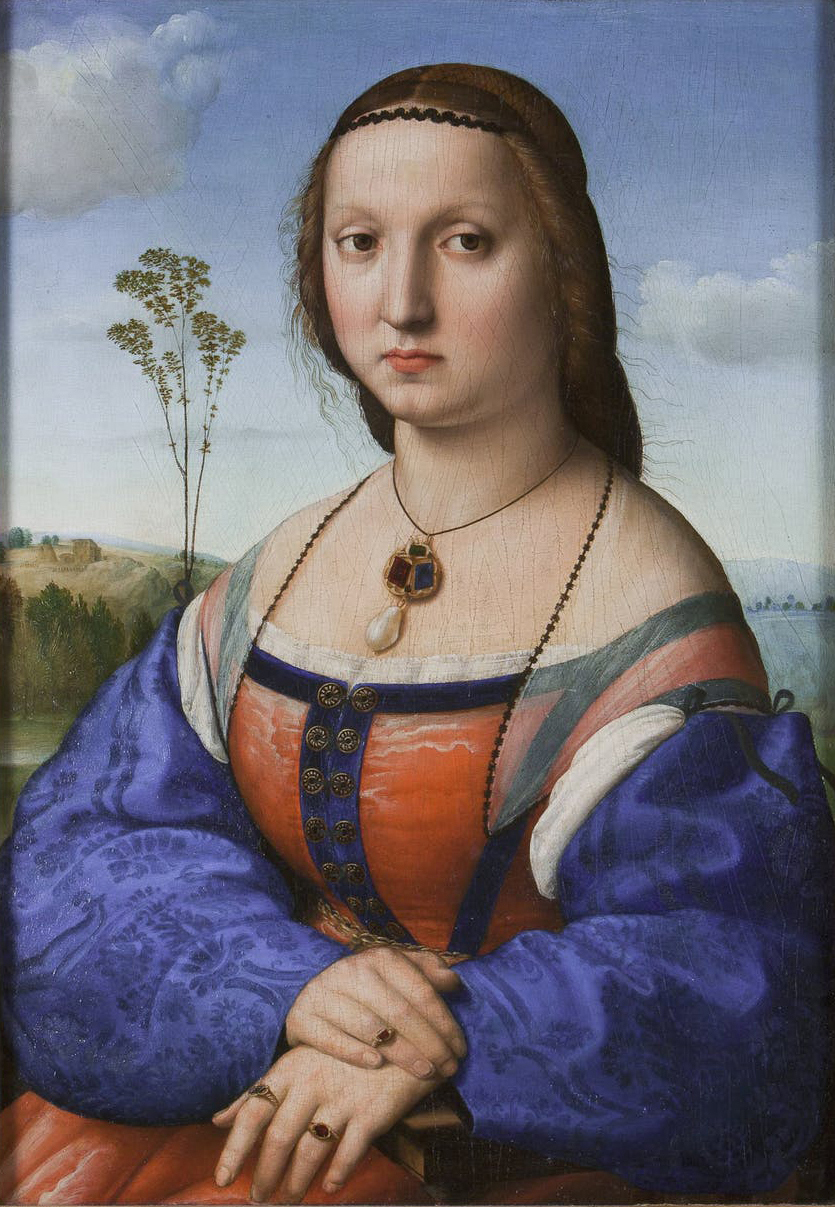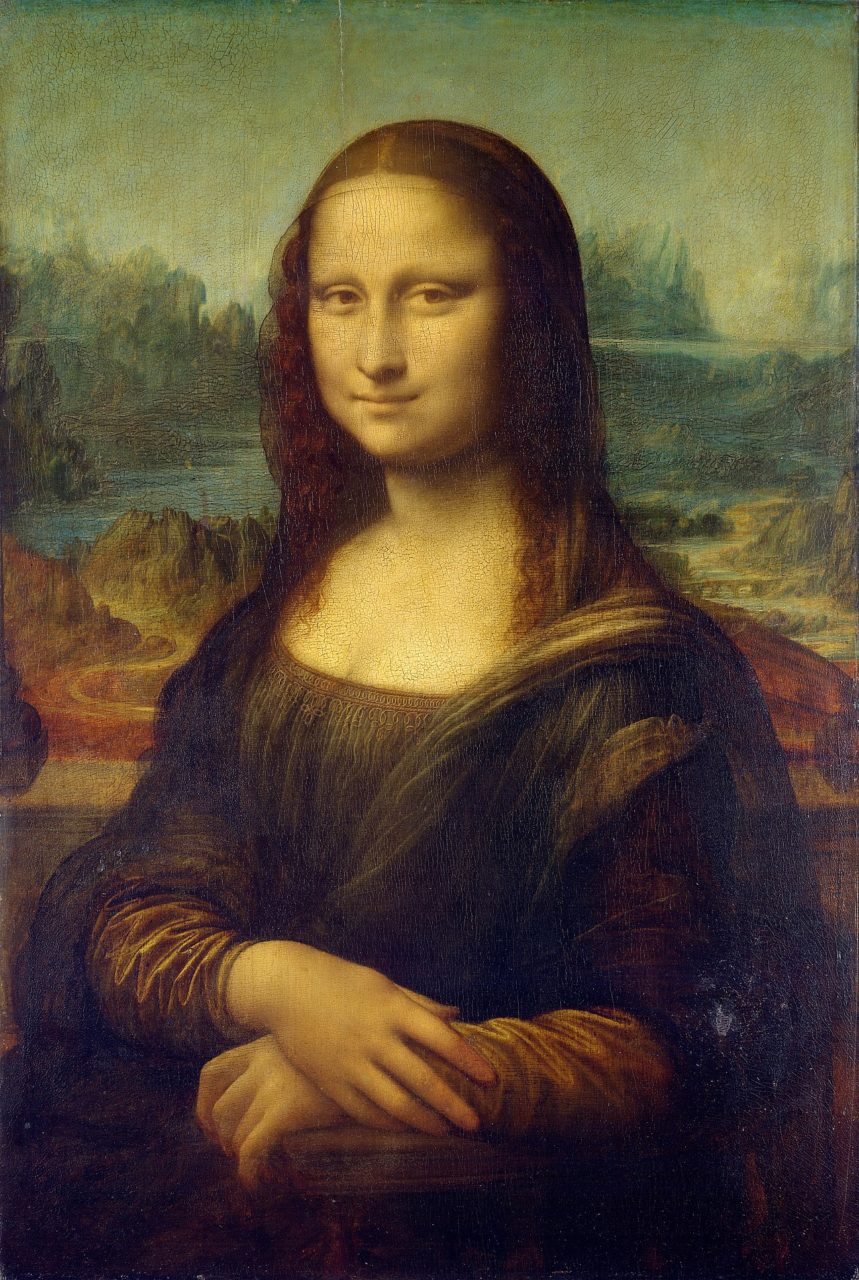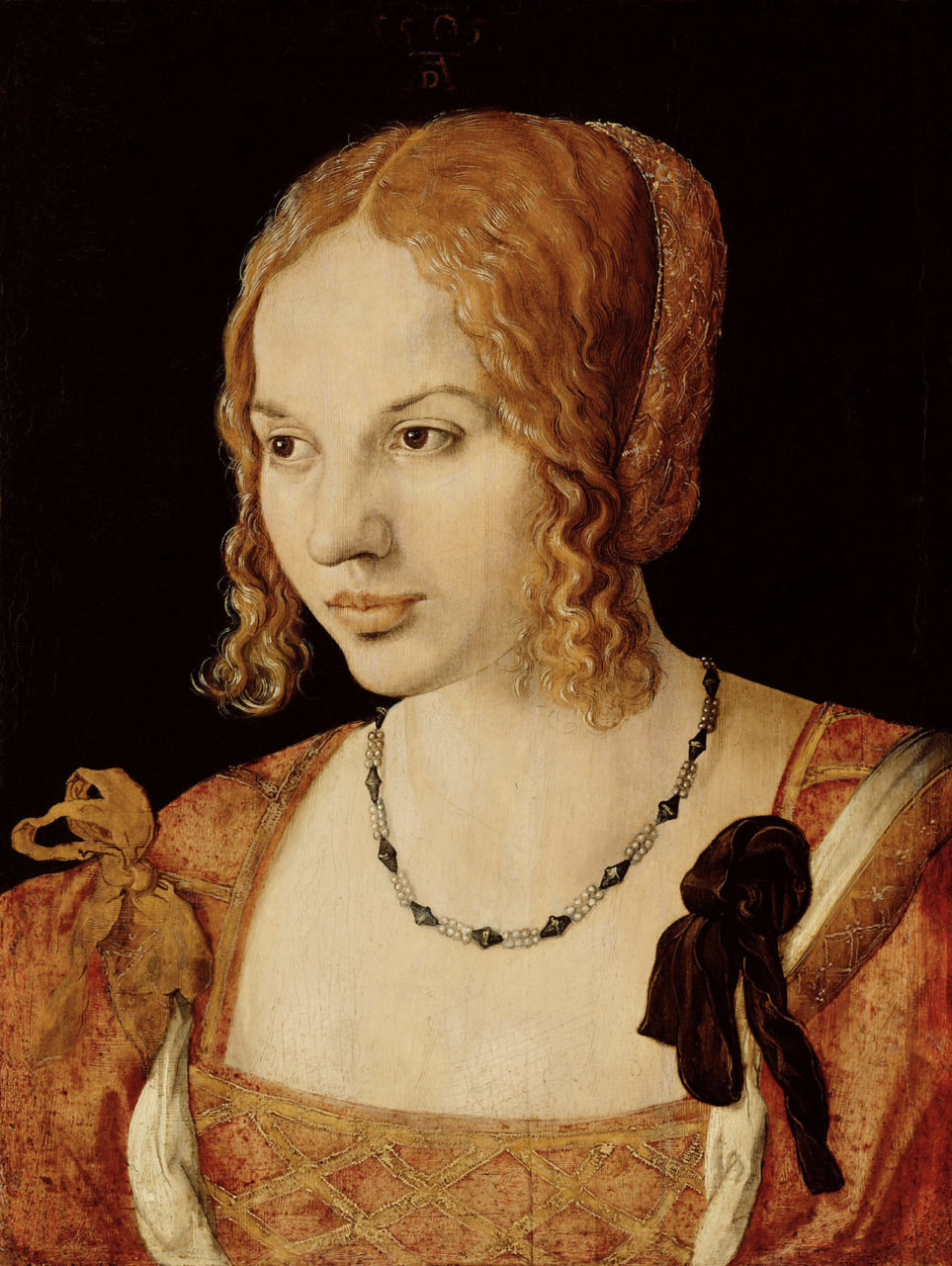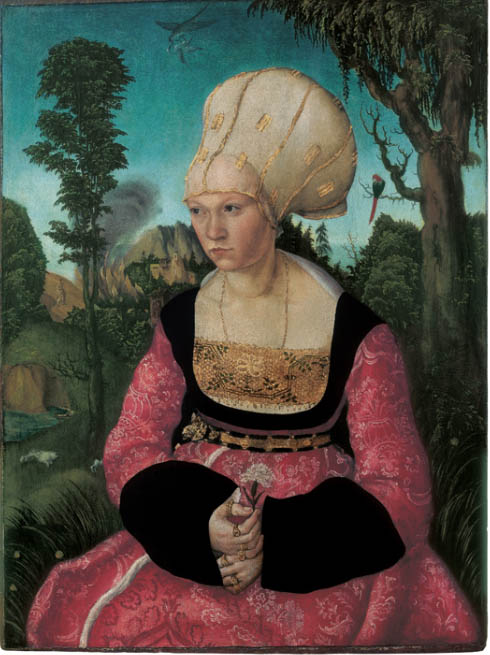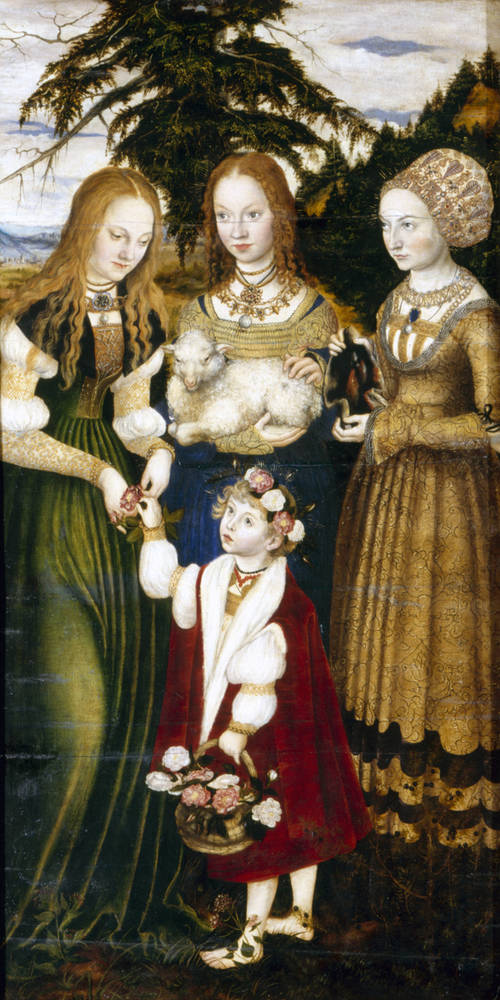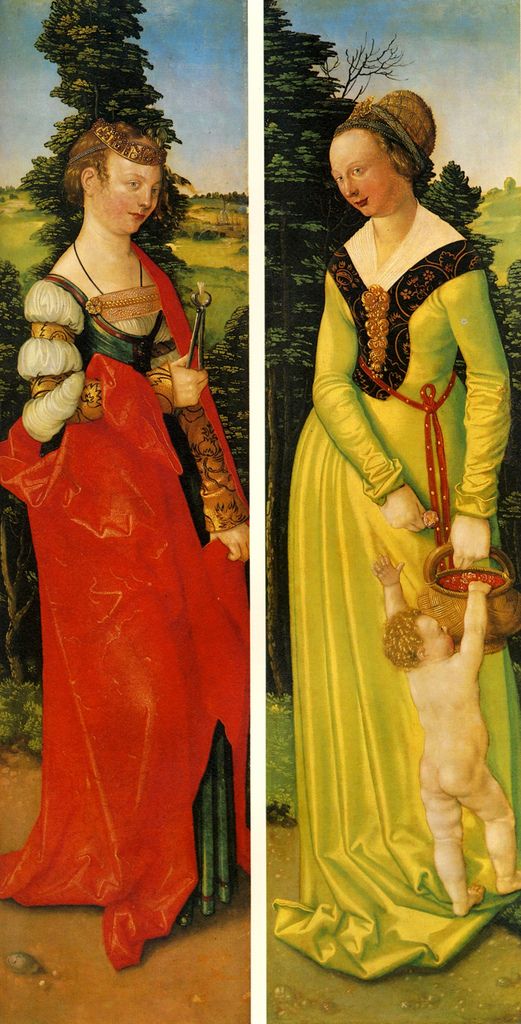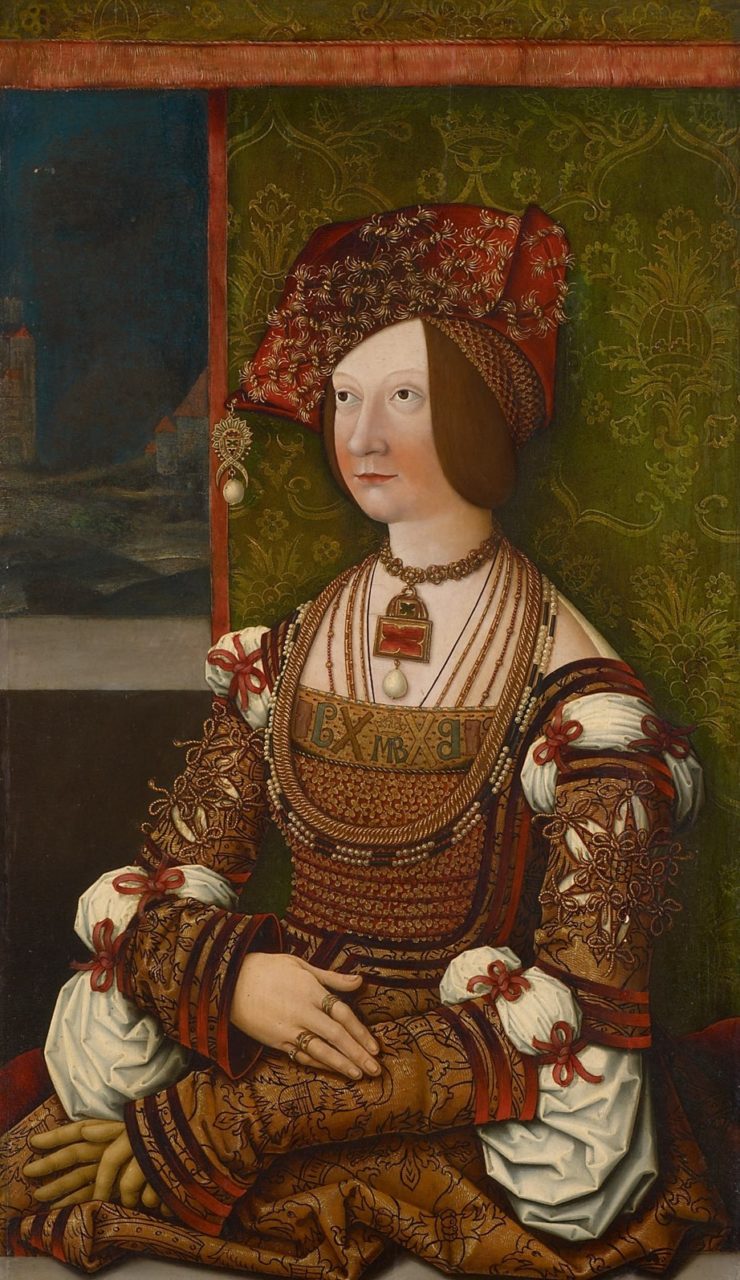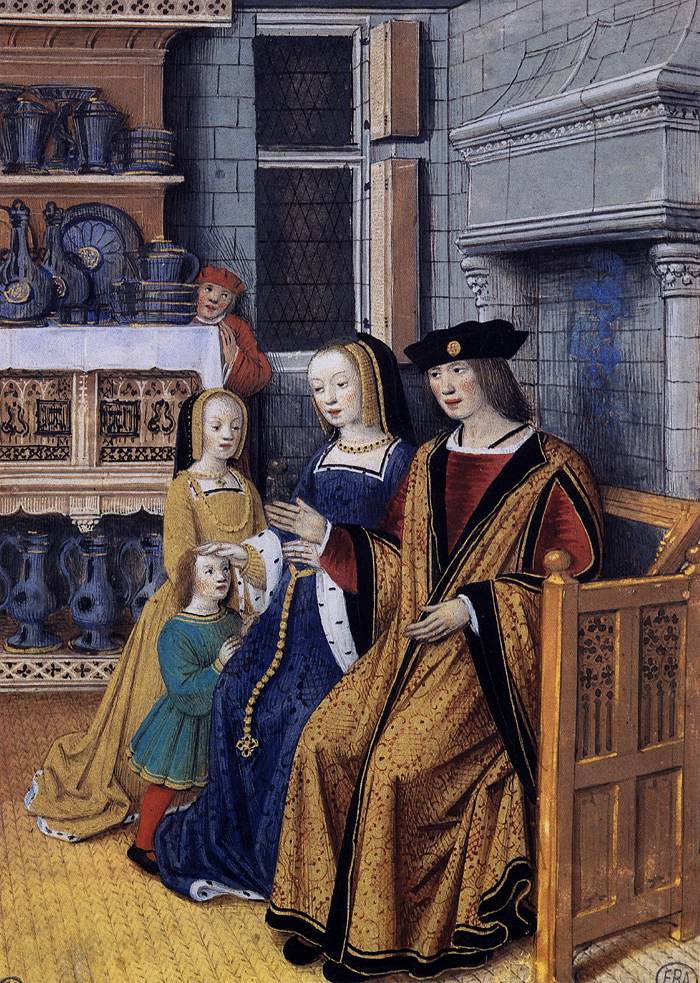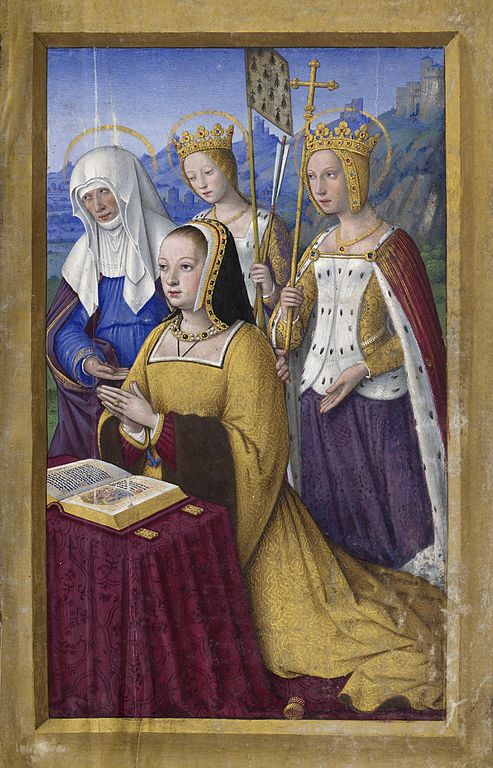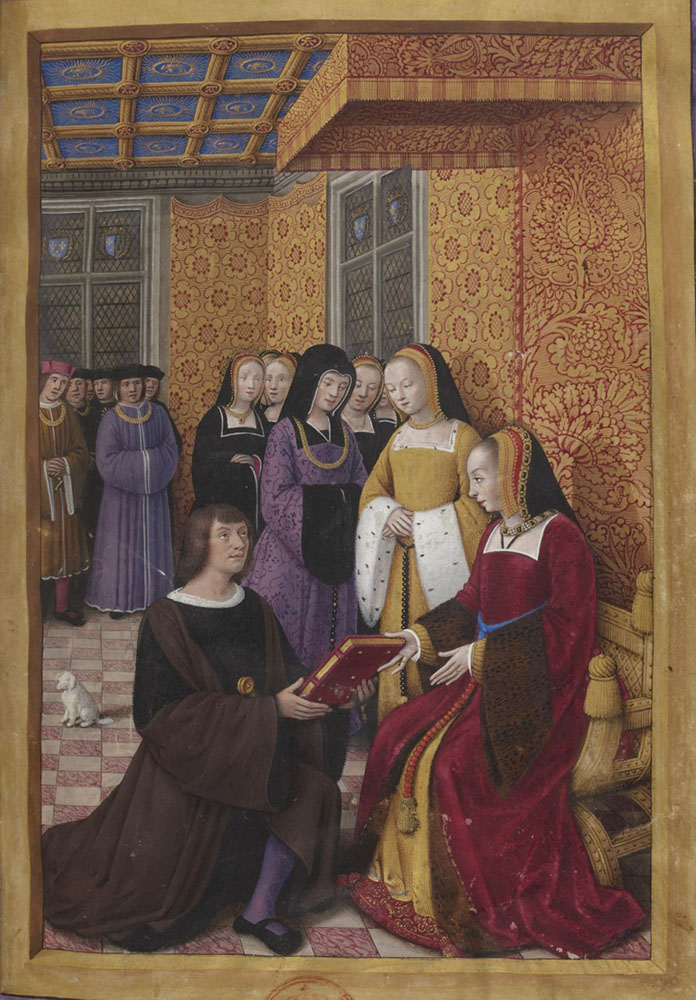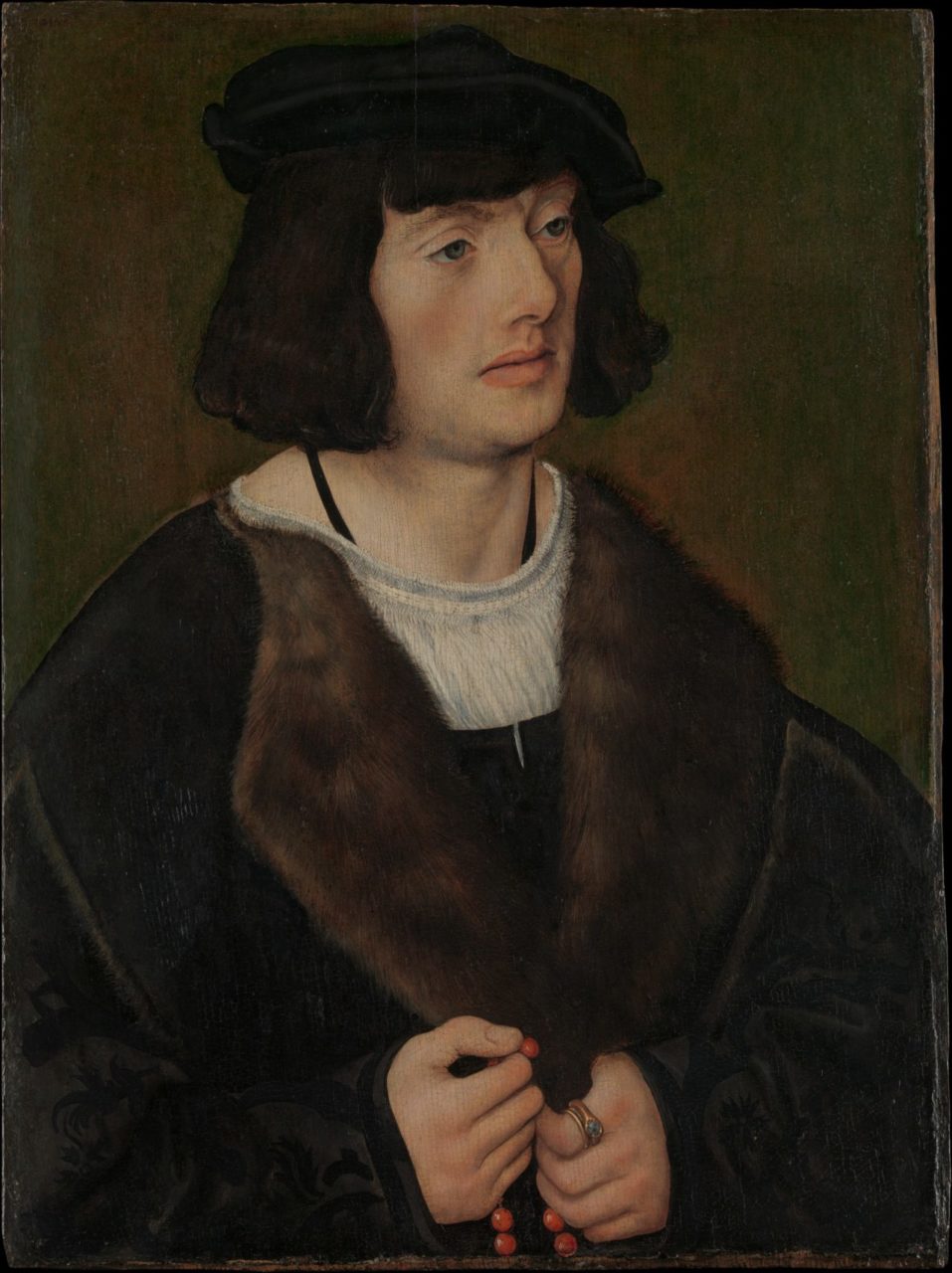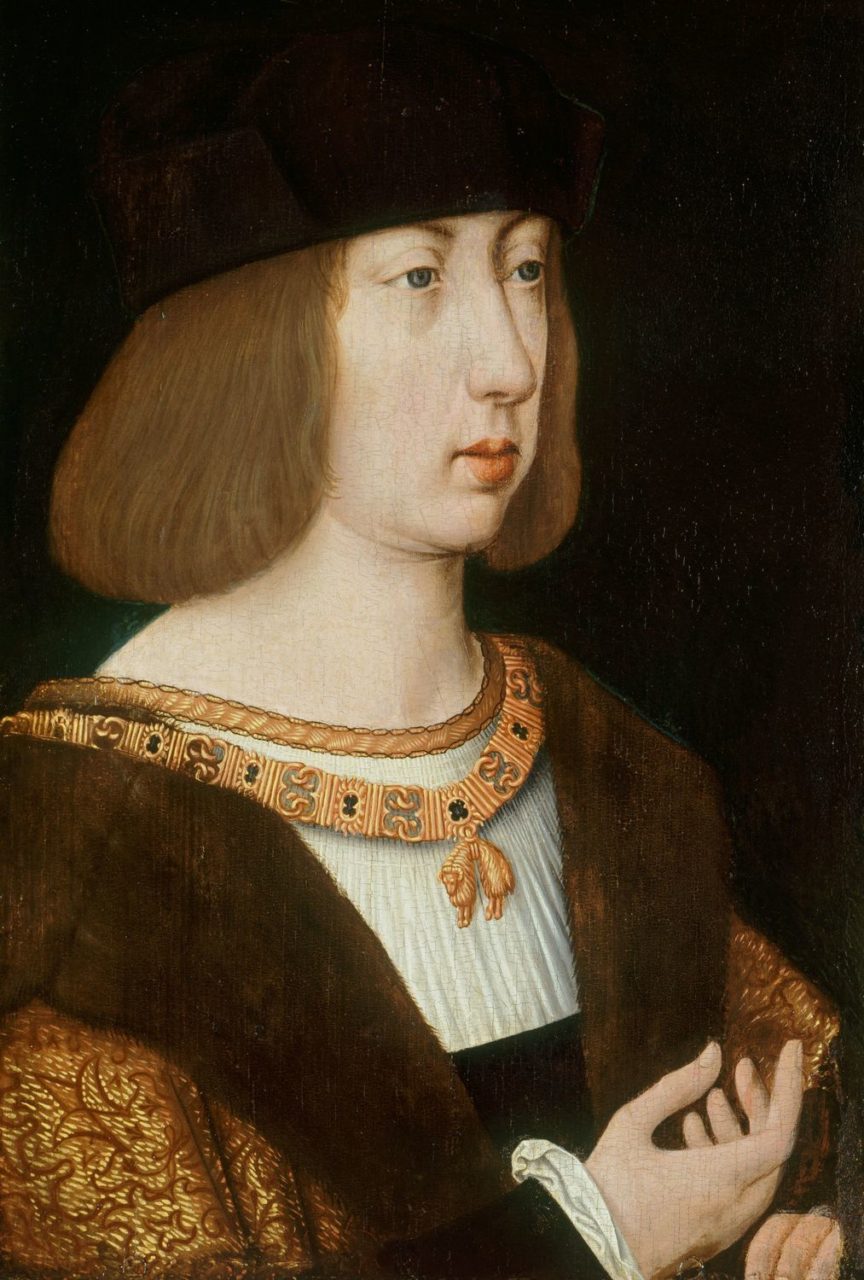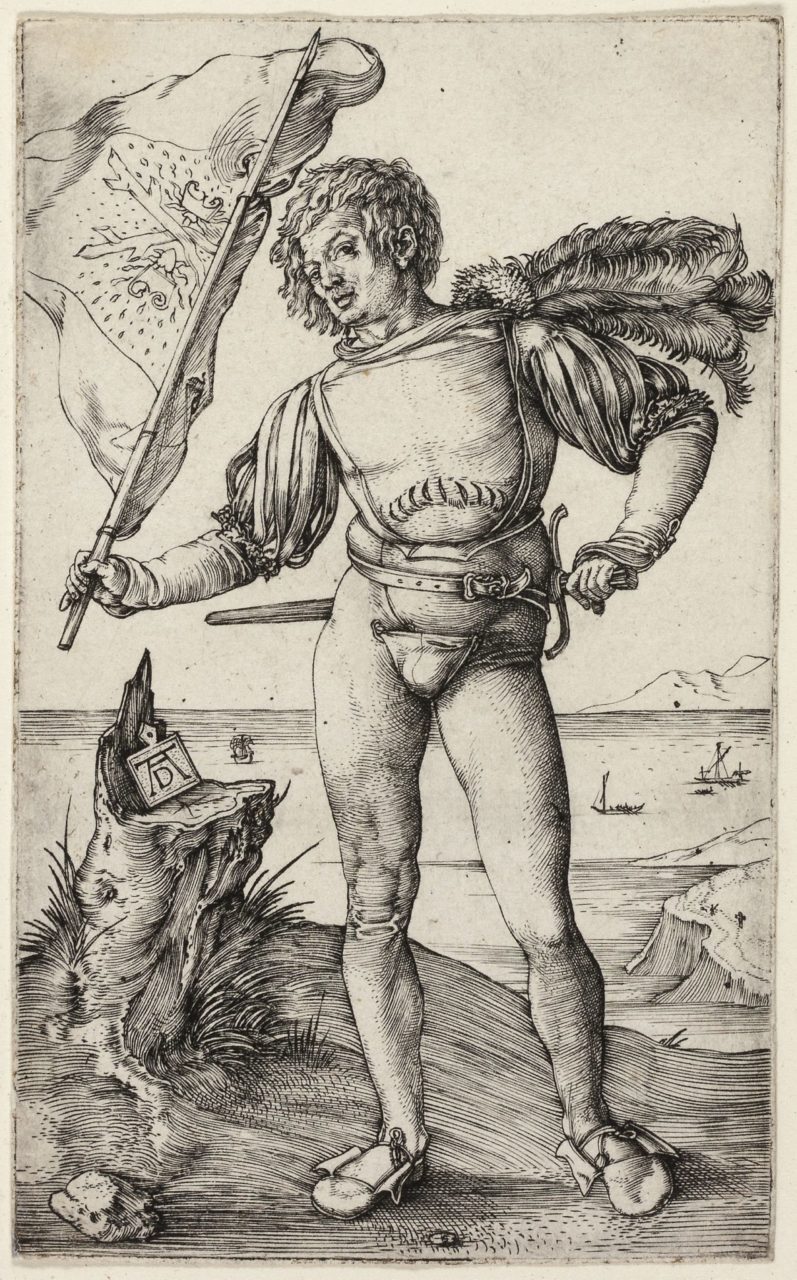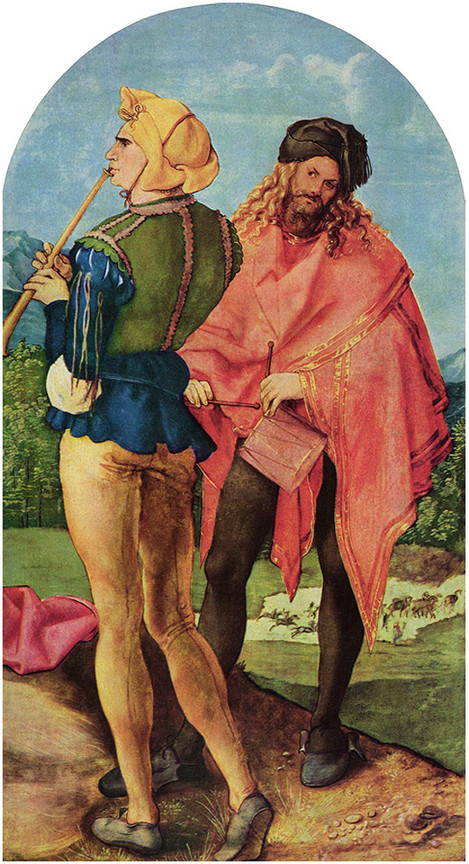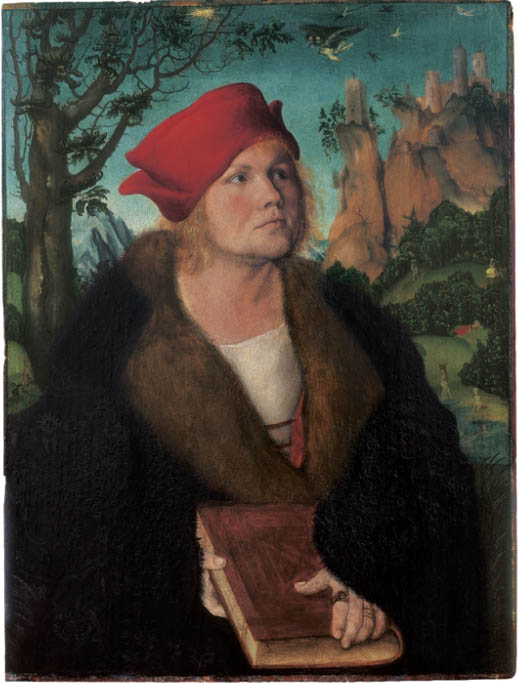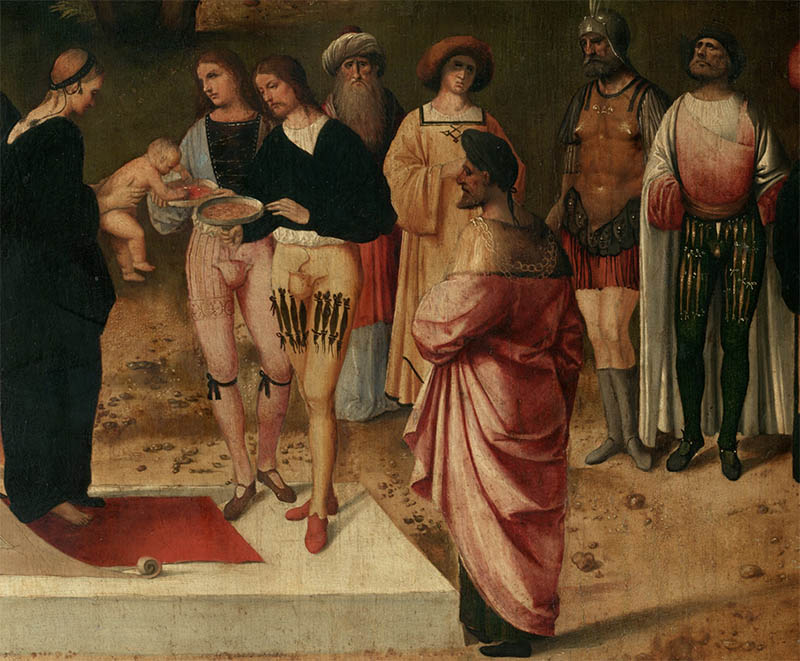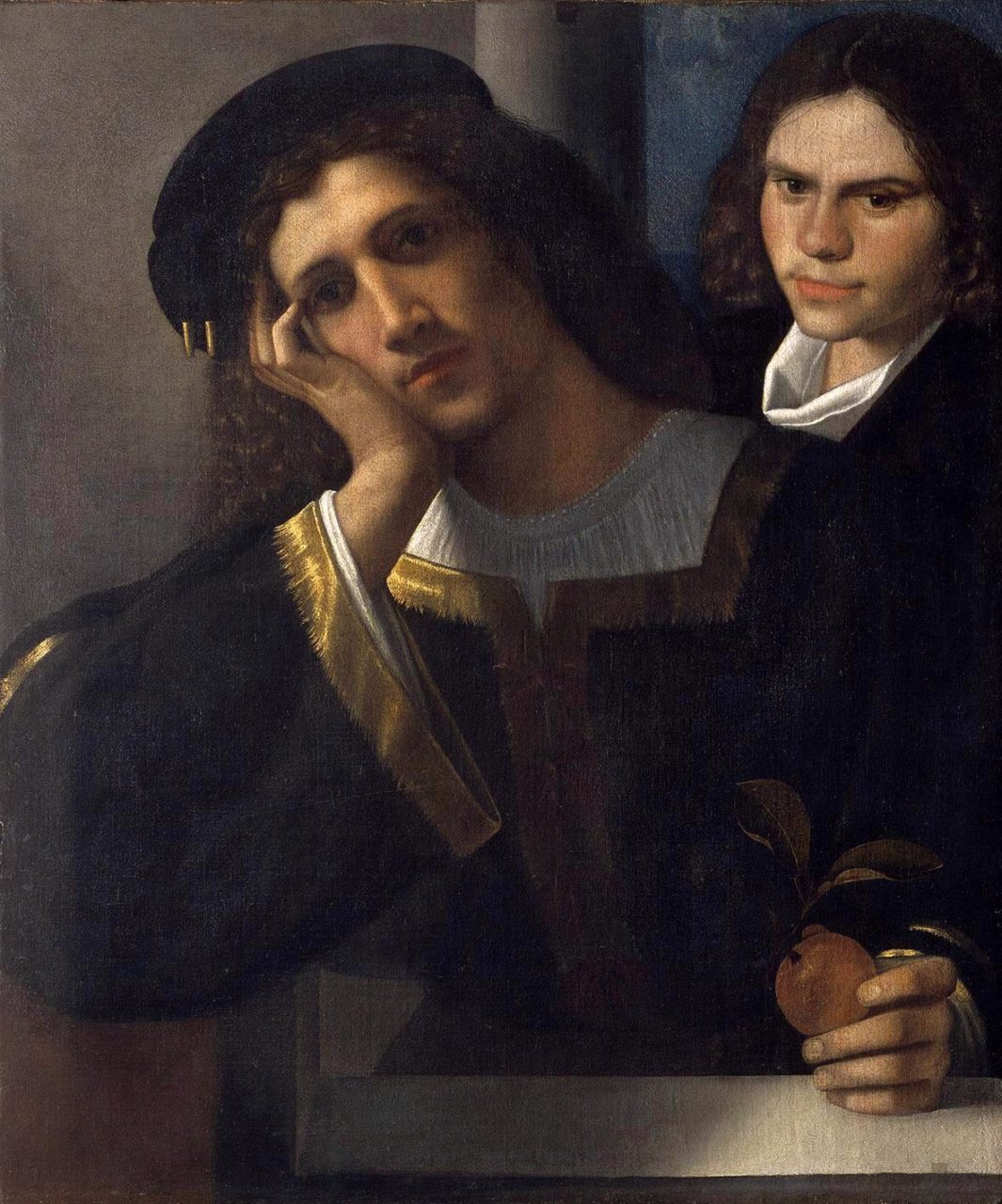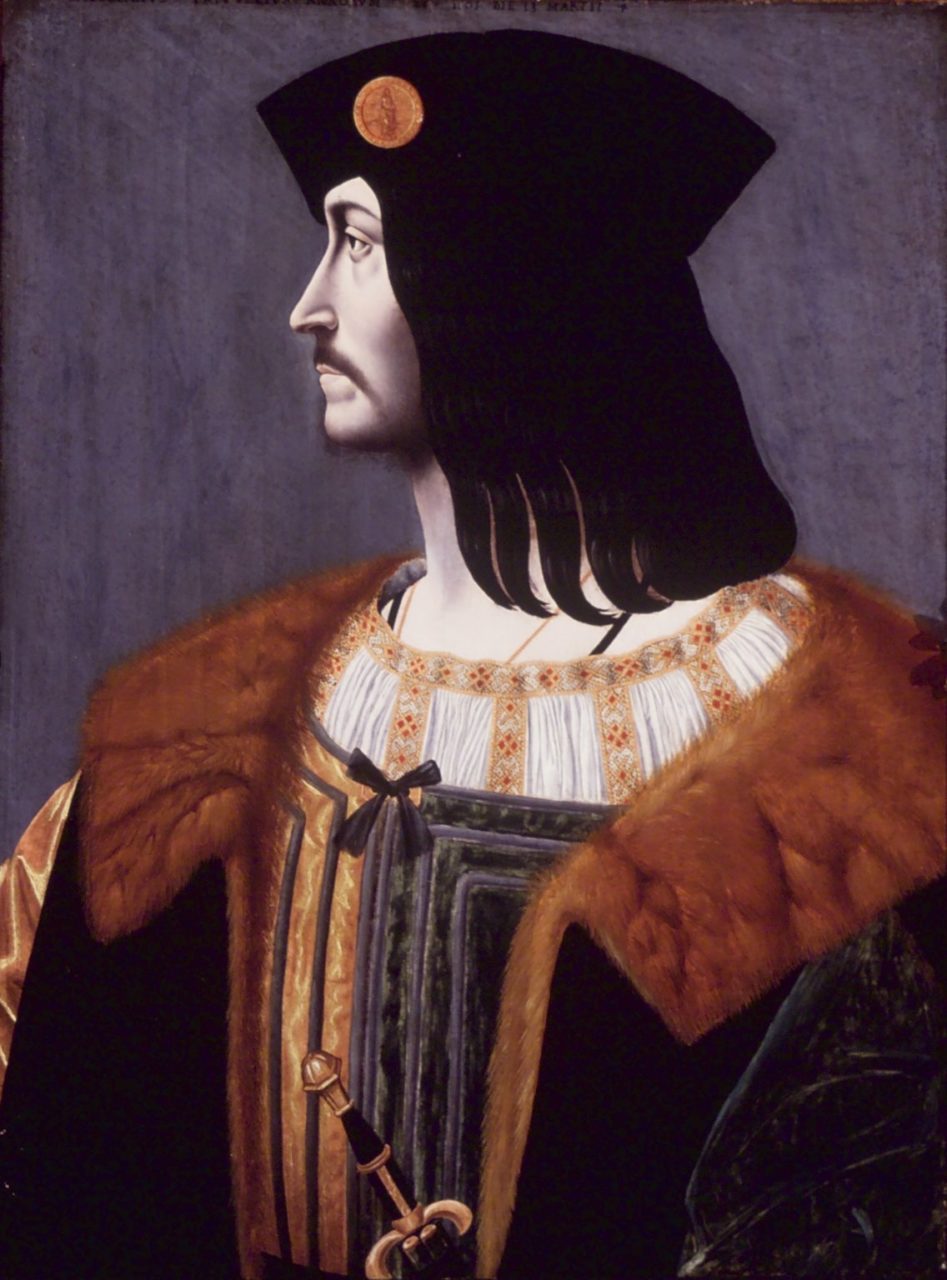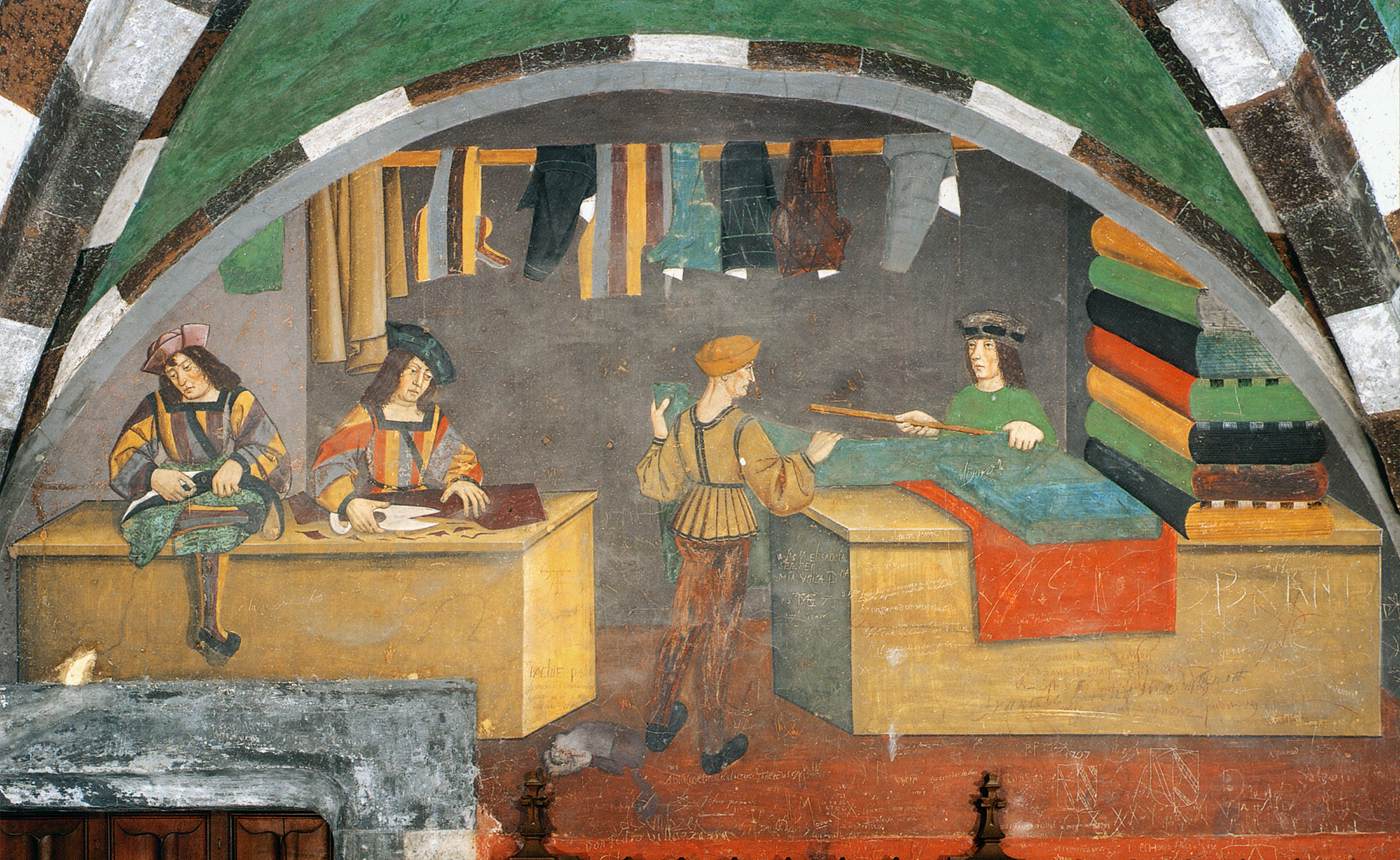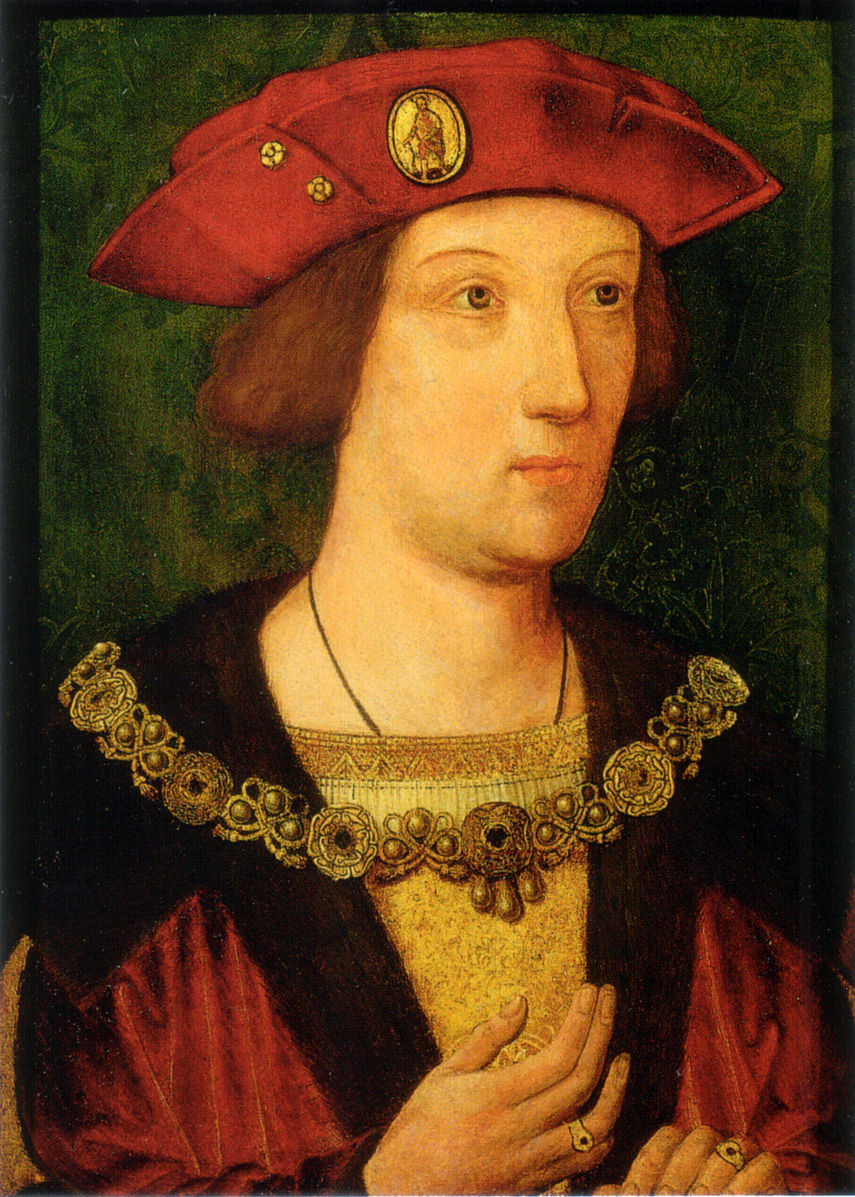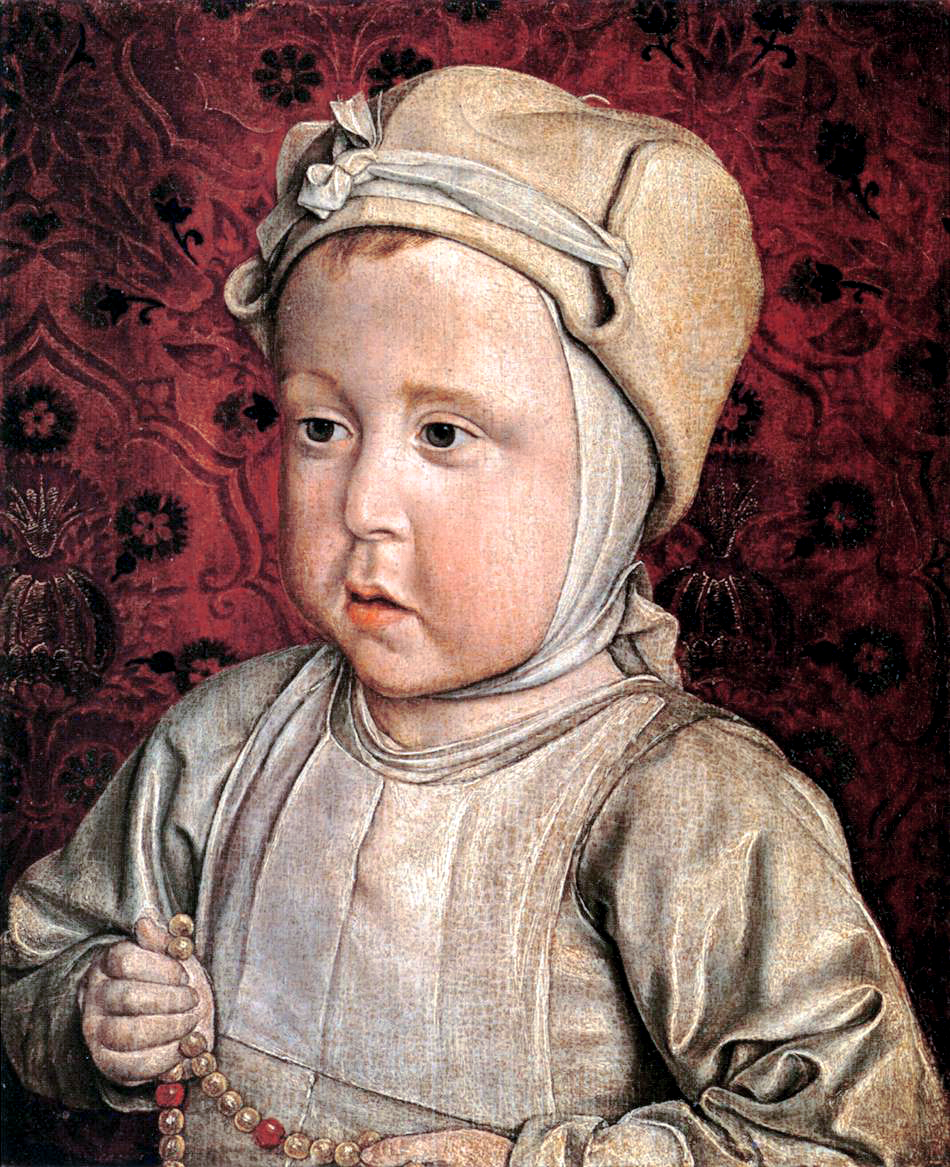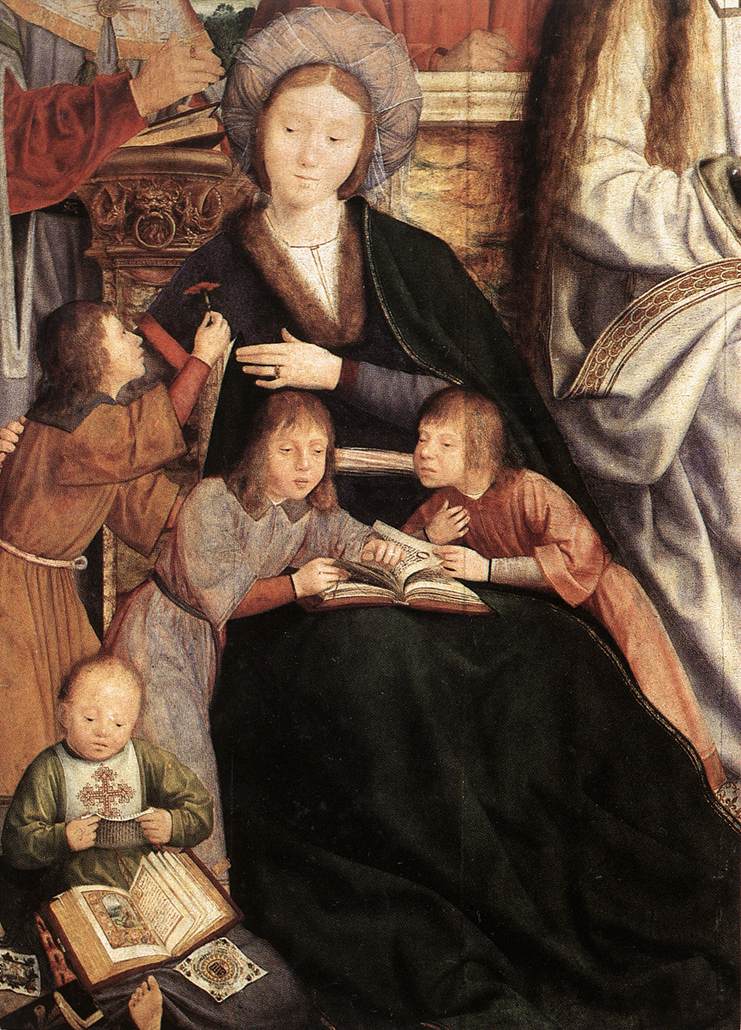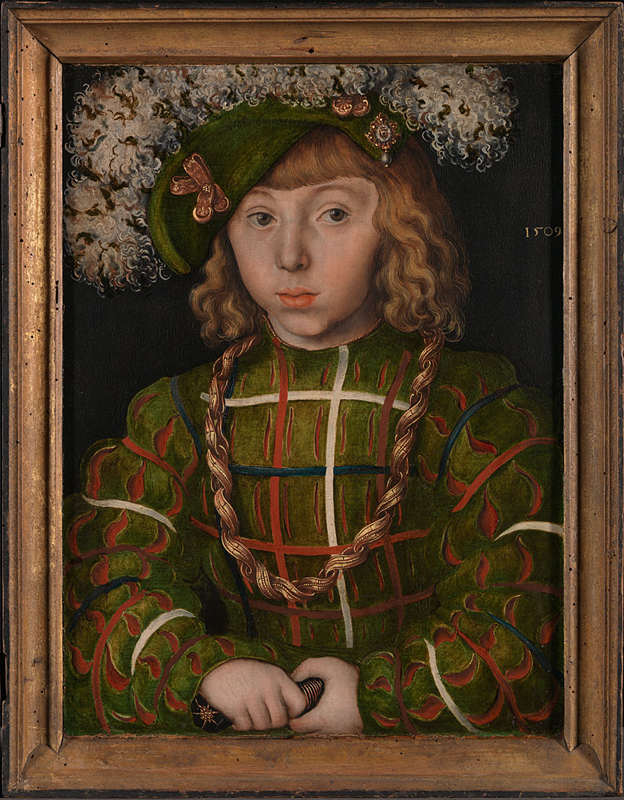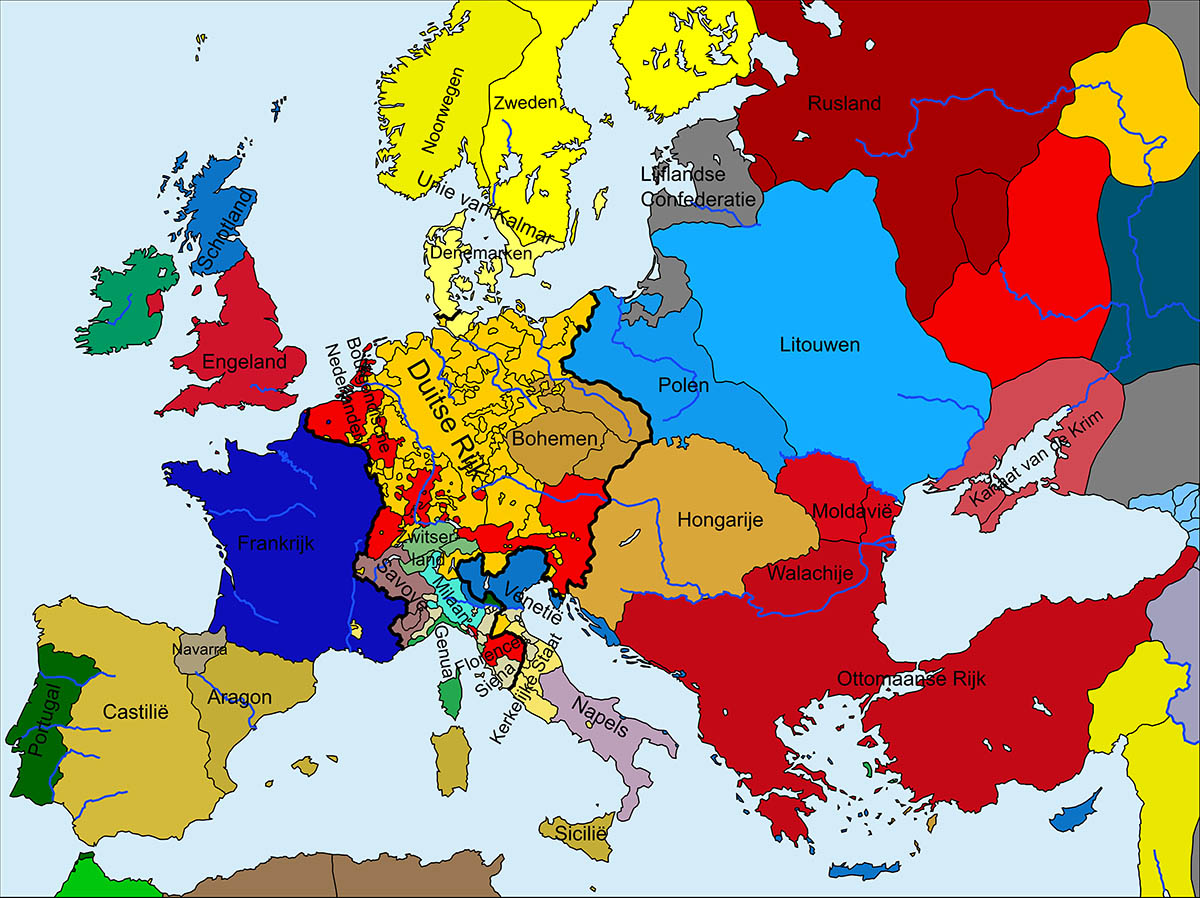OVERVIEW
Fashion in the first decade of the sixteenth century largely continued the trends of the 1490s, but with a growing Italian influence on men’s and womenswear producing a broader silhouette, as well as an increasing presence of slashing on men’s garments.
Womenswear
At the start of the sixteenth century, women dressed as they had for much of the fifteenth century, though changes were slowly introduced. The foundation of a woman’s outfit was her smock/shift/chemise, which was made of linen and easily washed. Blackwork or other colored embroidery was commonly applied to chemise necks, fronts, and wrists. Next a woman would wear a kirtle (later called a petticoat), which could be a joined bodice and skirt, or just the skirt; sleeves, when present, were close-fitting to the wrist and likely made of finer fabric—as indeed any part of the kirtle that was visible tended to be.
Atop her kirtle a woman of fashion would wear a gown. This upper robe, worn over the kirtle and chemise, was often voluminous with ample skirt and train. Its sleeves often had a large opening at the wrist and the cuffs were often turned back with a contrasting color or fur lining. Girdles or belts were almost always worn, as were stockings (or hose), held up with garters.
In Spain
Joanna of Castile, Queen of Castile from 1504, reflects these late 15th- and early 16th-century trends in a donor portrait on the Last Judgement Triptych of Zierikzee (Fig. 1). She wears a gown with a square neckline, as well as an ample skirt and train. Her large gold brocade gown sleeves have a large opening at the wrist and appear to be fur-lined. She wears a hood headdress with elaborate edge decoration (later termed a French hood) in the donor portrait and a contemporaneous half-length portrait (Fig. 2). In the standalone portrait, her black kirtle with gold lace trim is visible beneath her red gown and the kirtle’s narrow sleeves, also edged in gold, emerge from her gown’s fur-lined cuffs (her white chemise cuffs are also visible).
Neither image reveals the presence of a Spanish farthingale, or hooped underskirt, that will come to dominate the feminine silhouette in later decades. A description of Katherine of Aragon upon her marriage to Prince Arthur in 1501 mentions the farthingale’s traditional hoops:
“her gown was very large, bothe the slevys and also the body with many plightes, much litche unto menys clothyng, and aftir the same fourme the remenant of the ladies of Hispanyne were arayed; and beneath her wastes certayn rownde hopys beryng owte ther gownes from the bodies aftir their countray maner.” (Elizabethan Costume)
[“her gown was very large, both the sleeves and also the body with many pleats, much like unto men’s clothing, and after the same form the raiment of the ladies of Spain were arrayed; and beneath their waists certain round hoops bearing out their gowns from the bodies after their country’s manner.”]
Katherine, who later married Henry VIII, is traditionally said to have brought the Spanish farthingale to England upon her marriage to Arthur at the start of the 16th century, but they were not extensively adopted in England until the 1540s (Reynolds 41).
Fig. 1 - Master of Afflighem. Last Judgement Triptych of Zierikzee, detail. Juana I de Castilla, ca. 1500. Brussels: Royal Museums of Fine Arts of Belgium. Source: Wikipedia
Fig. 2 - Master of Affligem (Flemish, active 1470-1500). Juana I de Castilla, ca. 1500. Valladolid: Museo Nacional de Escultura. Source: Wikipedia
Fig. 3 - Artist unknown. Elizabeth of York, late 16th century, based on a work of circa 1500. Oil on panel; 56.5 x 41.6 cm (22 1/4 x 16 3/8 in). London: National Portrait Gallery, NPG 311. Source: National Portrait Gallery
In England
In England under Henry VII (1485-1509), women wore, as Francois Boucher notes in A History of Costume in the West (1997): “low head-dresses, low-waisted gowns, and square necklines and long, tight sleeves” (242). Elizabeth of York (Fig. 3), wife of Henry VII, wears a red velvet gown with a square neckline and ermine-lined sleeves. Her gown has decorative trim typical of English dress, as the Cunningtons remark in their Handbook of English Costume in the Sixteenth Century (1954): “Bands of velvet (guards) or other trimming usually bordered the neck, with a central band from neck to hem which might also be trimmed” (57).
Elizabeth also wears an English gabled hood. The gabled hood’s key feature was the pointed arch (or gable) that was created by means of wires or other stiffened framework. Her hood is particularly ornate, as Jane Ashelford notes in her Visual History of Costume: The Sixteenth Century (1983): “[t]wo sets of lappets, one plain, the other decorated with pearls and jewels, fall in front of the shoulders, the rest of the hood falls behind” (21).
In Italy
In Italy, women girded their gowns slightly above the natural waistline. Lacing was used prominently to attach sleeves to the bodice of the gown, with the white of the chemise visible and sometimes puffed out. Bernardina Zaganelli da Cotignola’s Portrait of a Lady (Fig. 4), shows a young woman in a red gown with lacing at the sleeves left slightly open to reveal her white chemise below. She wears a fine hairnet or caul, along with a delicate circlet around her forehead and an impressive pearl necklace with a pendant jewel. Open necklines offered an obvious showcase for rich necklaces and jewelry began to be worn more now that the wimples, veils, and high collars favored in the 15th century were being discarded.
Raphael’s portrait of Maddalena Doni (Fig. 5) includes a similarly impressive pendant pearl necklace. Her chemise is visible along the low bustline and at the laced openings joining her sleeves to her bodice. She also wears a delicate black circlet in her hair. The large blue silk damask sleeves reflect the broader, more masculine silhouette that was becoming fashionable for men and women. Leonardo da Vinci’s Mona Lisa (Fig. 6) is more simply dressed, without the elaborate fabrics or jewels of Maddalena Doni, though her gown does seem to have gold embroidery at the neckline. The low neckline and broader silhouette are similar to Doni’s and her sleeves also seem to be laced to her bodice, though they are narrower than Doni’s. She wears a delicate dark veil rather than a circlet.
German artist Albrecht Dürer visited Venice in 1505 and his portrait of an unknown Venetian woman (Fig. 7) confirms these trends, with its low neckline, laced sleeves, and delicate caul (hair net).
Fig. 4 - Bernardino Zaganelli da Cotignola (Italian, 1460-1510). Portrait of a Lady, 1500. Oil on panel; 33 x 25 cm. Liechtenstein: The Princely Collections, Inv.-No. GE935. Source: Liechtenstein
Fig. 5 - Raffaello Sanzio (Italian, 1483-1520). Maddalena Doni, ca. 1504-1507. Oil on basswood panel; 63.5 x 45 cm. Florence: Uffizi, Inv. 1912 nos. 61. Source: Uffizi
Fig. 6 - Leonardo da Vinci (Italian, 1452-1519). Portrait of Lisa Gherardini, wife of Francesco del Giocondo, known as the Mona Lisa, 1503-1517. Oil on poplar; 77 x 53 cm. Paris: Musee du Louvre, INV. 779. Acquired by François I in 1518. Source: Louvre
Fig. 7 - Albrecht Dürer (German, 1471-1528). Half-length portrait of a young Venetian woman, 1505. Oil on spruce; 32.5 × 24.2 cm. Vienna: Kunsthistorisches Museum, Picture Gallery, 6440. Source: Kunsthistorisches
Fig. 8 - Lucas Cranach the Elder (German, 1472-1553). Portrait of Anna Cuspinian, 1502. Oil on spruce wood; 60.1 x 45.5 cm (23.6 x 17.9 in). Zurich: Winterthur, 1925-1a. Source: Winterthur
In Northern Europe
In Northern Europe, womenswear remained Gothic with Italian influences, including lower square necklines. Daniel Delis Hill summarizes German trends in his History of World Costume and Fashion (2011):
“The gowns of German women in the early sixteenth century featured snug-fitting bodices, usually laced tightly, with low waistlines. For upper class women, richly embroidered or embellished panels were stitched across the bosom. Deep, open necklines were usually covered by smooth, sheer partlets or linen chemises. Sleeves were narrow with long cuffs that extended to the knuckles.” (380)
Lucas Cranach the Elder’s portrait of Anna Cuspinian (Fig. 8) reflects these trends; the gap left by her extremely low-cut black bodice is filled by a panel of golden floral embroidery. Other low-cut bodices can be seen in figures 9 and 10, filled in both by embroidered chemise panels and also by a sheer partlet (Fig. 10) on the figure at right. Both altarpieces also attest to the fact that German women favored narrow sleeves, often with gaps where their chemises would be puffed out. Anna Cuspinian wears a headdress typical of Germany, which Millia Davenport describes in her Book of Costume (1948): “over jeweled cauls at the ears, embroidered gauze is drawn across the forehead and about the bulbous cap, set far back in the head” (382). German women particularly favored heavy gold chains, often worn in multiples (Fig. 9).
Bianca Maria Sforza, born in Milan, became Holy Roman Empress in 1508 and thus her portrait from around that time (Fig. 11) reflects Northern trends, like the narrow sleeves laced together and the low-cut bodice filled in with bands of decorative embroidery and many gold chains.
Fig. 9 - Lucas Cranach the Elder (German, 1472-1553). Altar of Saint Catherine, 1506. Oil on lindenwood; 121,4 x 64 cm. Dresden: Staatliche Kunstsammlungen, Gal.-Nr. 1906 BB. Source: SKD
Fig. 10 - Hans Baldung Grien (German, 1480-1545). Sts. Dorothy and Apollonia from the St.Sebastian Altar, 1507. Private Collection. Source: Pinterest
Fig. 11 - Bernhard Strigel (German, 1461-1528). Bianca Maria Sforza (1472-1510), Kaiserin, Halbfigur, 1505/10. Oil on wood; 76 x 43.5 cm. Vienna: Kunsthistorisches Museum, Gemäldegalerie, 4404. Source: Kunsthistorisches
In France
Women in France dressed as they had in the 15th century, but with greater richness in material and decoration, as well as Italian influences. In Jean Bourdichon’s Wealthy Man (Fig. 12) the wife figure wears a blue brocade gown with a low, square neckline and ermine-lined sleeves. This is paired with a kirtle with gold sleeves, a golden girdle (belt) and a French hood.
For further discussion of French fashions, see the “Fashion Icon” section on Anne of Brittany below. For discussion of the children’s dress seen in the Wealthy Man, see the “Children’s wear” section.
Fig. 12 - Jean Bourdichon (French, 1457-1521). The Wealthy Man, 1500-10. Paris: École nationale supérieure des Beaux-Arts. Source: Wikipedia
Fashion Icon: Anne of Brittany (1477-1514), Queen of France
Fig. 1 - Jean Bourdichon (French, 1457-1521). Grandes Heures d'Anne de Bretagne - f. 3r - Anne de Bretagne entre trois saintes, 1508. Parchment; 30 x 19 cm. Paris: Bibliothèque nationale de France, Latin 9474. Source: BNF
Fig. 2 - Jean Bourdichon (French, 1457-1521). Jean Marot, Le Voyage de Gênes, 1507-08. Parchment; 31 x 21 cm. Parus: Bibliothèque nationale de France, Français 5091. Source: BNF
Anne of Brittany (1477-1514) was Duchess of Brittany and twice crowned the Queen of France. She first was married by proxy to Maximilian I of Austria, but Charles VIII of France insisted she marry him instead, which she did in 1491. As Duchess, Anne had significant resources to draw upon and for her marriage to Charles she arrived:
“dressed in a gown of black velvet and satin, costing over 60,000 francs, and swathed in a velvet cloak, trimmed with 139 sable pelts…. Even more extravagant was Anne’s wedding dress – of ‘drap d’or trait-enlevé’ – a type of figured cloth-of-gold, at 7,350 francs the yard, trimmed with sables.” (Tudor Times)
Upon Charles’s untimely death in 1498, Anne was compelled by treaty to marry his successor, Louis XII.
As Queen of France, Anne was a great patron of the arts, commissioning very fine illuminated manuscripts, most importantly the Grandes Heures of Anne of Brittany, and possibly the Metropolitan Museum of Art’s famous unicorn tapestries (Rorimer). An illumination in the Grandes Heures depicts Anne in prayer, surrounded by three saints (Fig. 1). She wears a golden silk damask gown with a square neckline with a slight rise at the center and an ample skirt and train. Her gown cuffs seem to be trimmed in sable and her kirtle sleeves are red, trimmed in gold. She wears a French hood, seemingly edged with diamonds (which often appear black due to their settings in this period), a substantial pearl and diamond-encrusted gold necklace, and a blue girdle.
She wears the same hood and necklace in another illuminated manuscript page (Fig. 2), though now paired with what appears to be a sable-lined, red velvet gown. Her kirtle forepart and sleeves are golden. The triangular opening of her gown that reveals the golden kirtle beneath is a trend that will become popular in later decades—notably none of her ladies in waiting have yet adopted it, though they all wear gowns with square-cut necklines, large sleeve openings and fur cuffs as Anne does. A woman of immense wealth, culture and taste, Anne dressed herself at the forefront of style as befitted her role as Queen of France and Duchess of Brittany.
Menswear
At the start of the sixteenth century, the first layer a man would put on would be his linen shirt or chemise, which in this period was nearly always visible and gathered at an often-ornamented neckband. Doublets were collarless, cut square and low. Sleeves were often of a finer fabric than the body as they were more visible when wearing a gown. Jerkins, often skirted, were worn over the doublet (it is often difficult to distinguish the two in portraits). Gowns, worn over doublets/jerkins, were broad-shouldered and loose, open down the front, with a large turned back collar that broadened over the shoulders and was usually fur lined. Legs were covered in hose ending at the knee, with the two legs joined by a codpiece; netherhose or stockings were worn below, supported by garters. Men were typically clean shaven, often with medium-length bobbed hair. Davenport describes variations in hair styling in the period, writing:
“Hair is worn in a long bob, often with bangs; typically of shoulder length and natural, but varying from lank and unkempt to exquisitely trimmed and tended, especially in Italy.” (344)
Soft bonnets with upturned brims, often ornamented with a medallion, were frequently worn. Duckbill shoes, which replaced the 15th-century pointy-toed poulaine, were square with rounded corners.
Lucas Cranach the Elder’s Portrait of a Man with a Rosary (Fig. 1) captures many of these trends: from the highly visible, finely gathered white chemise with ornamented neckband to the low, square black doublet/jerkin neckline and the broad-shouldered, loose gown with ample turned back fur revers. He is clean shaven and has a shoulder-length bob.
Philip the Handsome, Duke of Burgundy and husband of Joanna of Castile (Figs. 1 & 2 above), demonstrates many of the same trends, but, unsurprisingly given his rank, in much finer fabrics (Fig. 2).
Maria Hayward describes the types of furs that were commonly worn (by men and women) in Rich Apparel: Clothing and the Law in Henry VIII’s England (2009):
“In the early sixteenth century, dark and light furs were very popular instead of the bright red/brown furs favoured in the fourteenth and fifteenth centuries. Dark furs included sable and the darker the fur, the more highly they were prized, so making black coney, black lamb or budge and black genettes all in demand. These would be used either with black gowns to indicate understated wealth or to form a strong contrast with paler fabrics. Equally, pale furs, such as mink, ermine, lettice (a pale white or grey fur from the snow-weasel), lynx and the light coloured belly fur of the leopard or libbard, were also popular and used to striking effect on dark fabrics.” (102)
As we saw above, Anne of Brittany was a tremendous consumer of sable fur, as all fashionable men and women who were permitted to wear such furs were.
Fig. 1 - Lucas Cranach the Elder (German, 1472–1553). Portrait of a Man with a Rosary, ca. 1508. Oil on oak; 47.6 x 35.2 cm (18 3/4 x 13 7/8 in). New York: The Metropolitan Museum of Art, 29.100.24. H. O. Havemeyer Collection, Bequest of Mrs. H. O. Havemeyer, 1929. Source: The Metropolitan Museum of Art
Fig. 2 - Flemish School (16th century). Philip the Handsome (1478-1506), ca. 1500. Oil on wood panel; 31.7 x 21.7 cm. Windsor Castle, RCIN 403438. Source: Royal Collection Trust
Fig. 3 - Albrecht Dürer (German, 1471-1528). The Standard Bearer, ca. 1500. Engraving in black on ivory laid paper; 11.6 x 7.1 cm. Chicago: Art Institute of Chicago, 1938.1461. Clarence Buckingham Collection. Source: AIC
Fig. 4 - Albrecht Dürer (German, 1471 – 1528). Piper and Drummer, ca. 1503 – 1504. Limewood; 94 x 51 cm. Cologne: The Wallraf-Richartz-Museum & Fondation Corboud, WRM 0369. Collection of Ferdinand Franz Wallraf. Source: The Wallraf-Richartz-Museum & Fondation Corboud
Fig. 5 - Lucas Cranach the Elder (German, 1472-1553). Dr Johannes Cuspinian, 1502. Oil on pine; 60 x 45 cm (23.6 x 17.7 in). Zurich: Winterthur, 1925-1b. Source: Winterthur
In Northern Europe
In Northern Europe as everywhere, this was a transitional period, which saw the continuation of late Gothic styles with some adoption of Italian elements. The influence of Italian high Renaissance style is most notable in the necklines of men’s doublets and jackets, which became lower and began to reveal more of the shirt as we saw above. As Hill explains: “The high collars of the Gothic styles were eliminated in favor of the open, square and oval lines that had developed in Italy at the end of the 1400s” (373).
Particolored hose, while still worn, faded out of style in the first decade of the 16th century. Pointed-toe poulaines had begun to be replaced by broad-toe duckbill shoes at the end of the 15th century and became the dominant style in early 16th century. Slashing, the deliberate cutting of fabric for decorative effect, and pinking (a more regular, smaller version of slashing) were quite common.
Dürer’s etching of a standard bearer (Fig. 3) fighting for Maximilian I, the Holy Roman emperor, shows the typical Northern silhouette and stylistic elements; his doublet is pinked across the abdomen, while his jerkin sleeves are paned (regular strips of fabric left open to reveal the fabric below). His codpiece joining the two legs of his hose is prominent and he wears duckbill-style shoes. A Dürer painting from a few years later (Fig. 4) again shows the short doublet, this time skirted, with small paning at the shoulder; his sleeveless jerkin is green with scalloped edging at the armscye and applied ornamental braid (passementerie).
Johannes Cuspinian, husband of Anna (Fig. 8 above), wears an immense gown with fur revers and a soft red hat with upturned, notched brim (Fig. 5), commonly seen in Germany.
Fig. 6 - Giorgione (Italian, 1470s-1510). Moses undergoing Trial by Fire, detail, ca. 1505. Oil on panel; 72 x 89 cm. Florence: Uffizi. Source: Google Arts & Culture
Fig. 7 - Giorgione (Italian, 1470s-1510). Double portrait, 1502. Oil on canvas; 80 x 67.5 cm. Rome: Museo Nazionale di Castel Sant'Angelo. Source: Wikipedia
Fig. 8 - Raffaello Sanzio (Italian, 1483-1520). Agnolo Doni, ca. 1504-1507. Oil on basswood panel; 63.5 x 45 cm. Florence: Uffizi, Inv. 1912 nos. 61. Source: Uffizi
Fig. 9 - Bernardino de'Conti (Italian, documented 1494-1522). Portrait of Catellano Trivulzio, 1505. Tempera and oil on panel; 74 x 56.5 cm (29 1/8 x 22 1/4 in). Brooklyn Museum, 21.141. Bequest of A. Augustus Healy. Source: Brooklyn Museum
In Italy
Hill describes Italian fashion at the start of the 16th century, writing that:
“Sleeves became voluminous, and the arm opening dropped off the natural shoulderline emphasizing long necks and long, cascading hair. In the military fashion, doublets were commonly cropped at the waist to which the hose was attached.” (354)
Slashing (a northern trend) slowly becomes adopted by Italians as well. This growing foreign influence on dress prompted Venice in 1504 to ban garments “in the German fashion” (Boucher 222).
Moses undergoing Trial by Fire (Fig. 6) by Giorgione from around 1505 illustrates many of these trends. The men’s hose is slashed decoratively to reveal a contrasting underhose fabric, garters hold up the man in pink’s stockings and codpieces are in evidence, though only beginning to be decorated. Giorgione’s Double Portrait (Fig. 7) shows the now familiar low, square-cut doublet and exposed shirt; his doublet is edged in gold and two gold points dangle from his bonnet. The portrait emphasizes his long neck as Hill discussed above. Agnolo Doni, husband of Maddalena (Fig. 5 above), has the voluminous sleeves typical of the period (Fig. 8), though only a bit of his shirt collar is seen. Catellano Trivulzio is keen we not miss any detail of his own shirt, which is elaborately embroidered with gold thread (Fig. 9).
In France
Charles d’Amboise, French governor of Milan, (Fig. 10) resembles other noblemen we’ve seen thus far, with the addition of a medallion on his black bonnet as well as the collar of the Order of Saint Michael. His gown with its gold brocade sleeves, extensive fur revers and jeweled trim is particularly elaborate.
Murals at Issogne from ca. 1502 (Figs. 11-12) reveal the strong Italian influence on French fashion and a look at non-elite dress of the day.
Of particular interest in the market scene (Fig. 11), where men wear Italian-style bonnets with cut and laced together brims. Their doublets have loose, full sleeves, worn with pleated skirts. Particolored hose continues to be worn. The tailor’s shop mural (Fig. 12) contains even more elaborate parti-colored hose, both on the men and hanging at the rear of the shop, where hose with codpieces attached are visible. The abundance of particoloring makes sense given the murals earlier start date and perhaps the tendency of trends to live on longer in non-elite circles. Their vertically striped jerkins or doublets have the square open neck typical of the early 16th century.
Fig. 10 - Andrea Solario (Italian, 1460 -1524). Portrait of Charles d'Amboise, 1507. Oil on canvas; 52 x 75 cm (29.5 x 20.5 in). Paris: Louvre Museum, INV 674. Source: Louvre Museum
Fig. 11 - Artist unknown (Italian). Fruit and Vegetable Stands, Frescoes in Castello Challant, Issogne, 1489-1502. Fresco. Valle d'Aosta: Issogne Castle. Source: Web Gallery of Art
Fig. 12 - Artist unknown (Italian). Tailor's and Fabric Shop, Frescoes in Castello Challant, Issogne, 1489-1502. Fresco. Valle d'Aosta: Issogne Castle. Source: Web Gallery of Art
Fig. 13 - British School (16th century). Arthur, Prince of Wales (1486-1502), ca. 1500. Oil on panel; 38.8 x 27.9 cm. Hampton Court Palace, RCIN 403444. Source: Royal Collection Trust
In England
Under Henry VII in England, men wore: “very short doublets, open-necked shirts, tight, often parti-coloured trunk hose” (Boucher 242) – not unlike the fashion in the French murals just described.
In terms of elite fashion, much is the same as elsewhere; Arthur, Prince of Wales, (Fig. 13) is shown wearing a low-necked doublet, with gold embroidered shirt band, a gown with fur revers and large cape collar, and a red bonnet with slashed brim and St. John the Baptist medallion. He wears a collar of red and white Tudor roses, signifying the uniting of the York (red rose) and the Lancaster (white rose) families by his father, Henry VII who married Elizabeth of York (Fig. 3 above) and ended the War of the Roses (1455-1487).
CHILDREN’S WEAR
In the early 16th century, infants were swaddled, and toddlers were dressed in simple linen smocks or chemises. Jean Hey gives a sense of what this looked like among the elite in his slightly earlier portrait of the Dauphin Charles-Orlant (Fig. 1). For practical reasons, boys and girls were dressed in dresses from the age of 2 until they were 5 or 6, when they began to wear miniature versions of adult dress. In Quentin Massys’ St. Anne altarpiece (Fig. 2), we can see children in both stages; the youngest child is in a green dress with crucifix bib, while the older boys are in simple versions of adult dress. Cranach’s portrait of Johann Friedrich the Magnanimous (Fig. 3) is, however, not at all simply dressed; his doublet/jerkin has elaborately paned sleeves cinched with red and white ribbons, which also decorate the deliberately slashed torso portion of the garment. He wears a heavy gold chain as was fashionable in Germany and his soft bonnet is decorated with medallions and a profusion of feathers.
Figures 9 & 12 in the womenswear section above show children in smaller versions of adult dress of the day. Cranach (Fig. 9) shows the young boy with the characteristic puffed Germanic sleeves and a red velvet gown. Bourdichon (Fig. 12) includes a young girl dressed identically to her mother—even including the ermine lining of her gown—whereas the youngest child wears a skirted doublet with red stockings, but no gown.
Fig. 1 - Jean Hey (Netherlandish, active 1475-1505). The Dauphin Charles-Orlant (1492-1495), 1494. Oil on panel; 39 x 33 cm (15.3 x 12.9 in). Paris: Louvre, RF 1942-28. Source: Wikipedia
Fig. 2 - Quentin Massys (Flemish, 1466-1530). St Anne altarpiece, detail, 1507-08. Oil on wood; 224.4 x 219 cm. Brussels: Musées Royaux des Beaux-Arts. Source: Web Gallery of Art
Fig. 3 - Lucas Cranach the Elder (German, 1472-1553). Portrait of Johann Friedrich the Magnanimous, 1509. Oil on wood; 42 x 31.2 cm. London: National Gallery, NG6539. Source: National Gallery
References:
- “Anne of Brittany.” Tudor Times. Accessed June 6, 2019. http://tudortimes.co.uk/people/anne-of-brittany-life-story/queen-of-france.
- Ashelford, Jane. A Visual History of Costume: The Sixteenth Century. London: Batsford, 1983. http://www.worldcat.org/oclc/748457696.
-
Boucher, François, Yvonne Deslandres, and John Ross. A History of Costume in the West: With 1188 Illustrations, 365 in Colour. London: Thames and Hudson, 1997. http://www.worldcat.org/oclc/443676264.
- Cunnington, C. Willett, and Phillis Cunnington. Handbook of English Costume in the Sixteenth Century. London: Faber and Faber, 1954. http://www.worldcat.org/oclc/362761.
- Davenport, Millia. The Book of Costume. New York: Crown Publishers, 1948. http://www.worldcat.org/oclc/922657048.
- Hayward, Maria. Rich Apparel: Clothing and the Law in Henry VIII’s England. Farnham, England: Ashgate, 2009. http://www.worldcat.org/oclc/990796848.
- Hill, Daniel Delis. History of World Costume and Fashion. Upper Saddle River, NJ: Pearson Prentice Hall, 2011. http://www.worldcat.org/oclc/768100950.
- “History of the Spanish Farthingale.” Accessed June 5, 2019. http://www.elizabethancostume.net/farthingale/history.html.
- Rorimer, James J. “The Unicorn Tapestries Were Made for Anne of Brittany.” The Metropolitan Museum of Art Bulletin 1, no. 1 (1942): 7-20. doi:10.2307/3257087.
Historical Context
Wikipedia: 1500-1509
Rulers:
- England: Henry VII (1485-1509)
- France: Louis XII (1498-1515)
- Spain:
- Ferdinand II (Castile 1475-1504, Aragon 1476-1516)
- Isabella I (Castile 1474-1504 )
- Joanna (Castile 1504-1555, Aragon 1516-1555)
Map of Europe, 1500. Source: Wikimedia Commons
Events:
- 1501 – Antwerp became Portugal’s trade center.
- 1502 – First reported African slaves in The New World.
- 1503 – Spain defeats France at the Battle of Cerignola. Considered to be the first battle in history won by gunpowder small arms.
- 1506 – Leonardo da Vinci completes the Mona Lisa.
- 1509 – Marriage of Katherine of Aragon to Henry VII of England starts a trend for geometric blackwork embroidery on linen clothing. Designs are inspired by patterns popular in Spain from Moorish culture.
- 1508–1512 – Michelangelo paints the Sistine Chapel ceiling.
- 1500-1560s – Men begin layering clothes to give bulk and width, especially at the shoulders, creating a square outline. They start wearing hose to show off their shapely legs, suggesting athleticism.
Timeline Entries
Primary/Period Sources
Resources for Fashion History Research
To discover primary/period sources, explore the categories below.
Have a primary source to suggest? Or a newly digitized periodical/book to announce? Contact us!
Digitized Primary/Period Sources
Secondary Sources
Also see the 16th-century overview page for more research sources… or browse our Zotero library.


